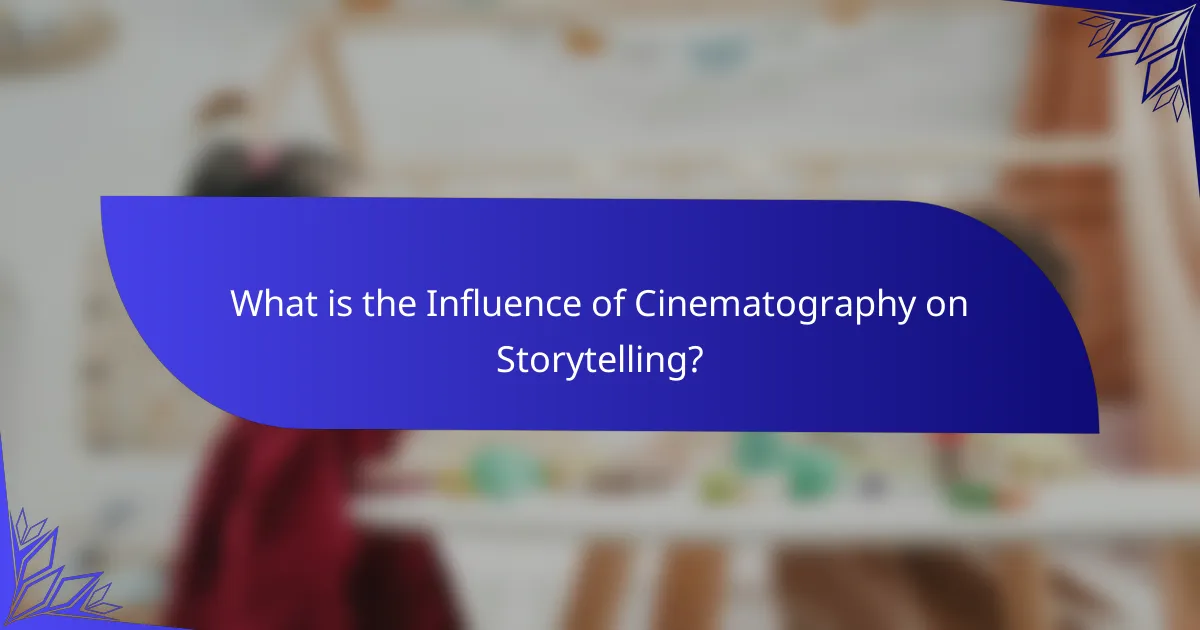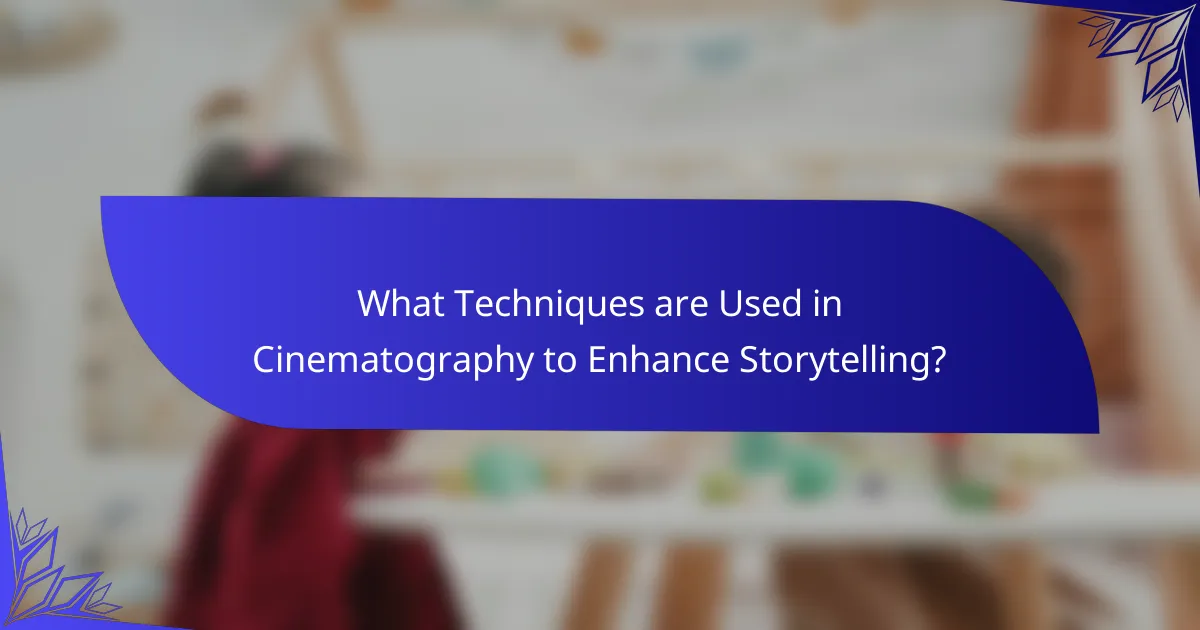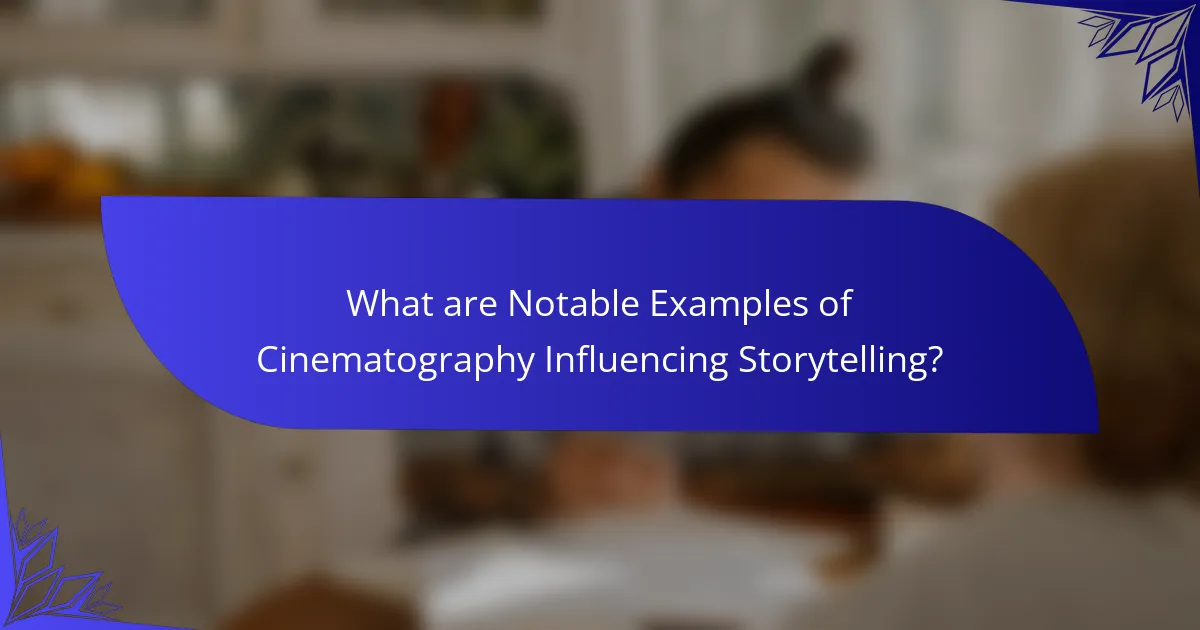Cinematography is a crucial element in storytelling, significantly impacting the visual narrative through techniques such as shot composition, lighting, and camera movement. These techniques shape the mood, tone, and atmosphere of a film, influencing audience perception and emotional engagement. The article explores how elements like low-key lighting create suspense, while wide shots convey isolation. It also examines notable films such as “The Godfather,” “Blade Runner,” and “Birdman,” highlighting how their cinematographic choices enhance narrative depth and viewer connection. Additionally, it discusses the role of color grading in reflecting time periods and evoking specific emotions.

What is the Influence of Cinematography on Storytelling?
Cinematography significantly influences storytelling by shaping the visual narrative. It employs techniques such as shot composition, lighting, and camera movement. These elements establish mood, tone, and atmosphere. For instance, low-key lighting can create suspense, while wide shots can convey isolation. The choice of camera angles affects audience perception of characters. Close-ups can evoke empathy, while high angles may suggest power dynamics. Historical films often use color grading to reflect time periods. A study by Bordwell and Thompson highlights how visual elements guide viewer emotions. Thus, cinematography is essential for enhancing narrative depth and audience engagement.
How does cinematography shape narrative in films?
Cinematography shapes narrative in films by visually conveying emotions and themes. It uses camera angles, lighting, and shot composition to influence audience perception. For instance, close-ups can evoke intimacy, while wide shots establish context. Lighting can create mood; high contrast may suggest tension, while soft lighting can imply warmth. Movement and framing guide viewer focus and pacing. Different styles, such as handheld versus steady shots, can reflect character states or narrative urgency. Studies show that visual storytelling significantly impacts audience engagement and interpretation.
What are the key elements of cinematography that impact storytelling?
The key elements of cinematography that impact storytelling include composition, lighting, camera movement, and color. Composition refers to the arrangement of visual elements in a frame. It guides the viewer’s focus and can enhance emotional responses. Lighting shapes the mood and tone of a scene. For instance, high contrast lighting can create tension, while soft lighting can evoke warmth. Camera movement influences pacing and perspective. Techniques like tracking shots can immerse the audience in action. Color conveys themes and emotions. For example, vibrant colors can signify joy, while desaturated tones may indicate despair. Each of these elements plays a crucial role in how a story is perceived and understood.
How do visual techniques enhance emotional engagement in a story?
Visual techniques enhance emotional engagement in a story by creating a deeper connection between the audience and the narrative. Techniques such as color grading evoke specific emotions; for example, warm colors can create feelings of comfort, while cool colors may induce sadness. Camera angles influence perception; low angles can make characters appear powerful, while high angles can depict vulnerability. Composition directs attention and highlights important elements, guiding emotional responses. Lighting sets the mood; bright lighting can signify happiness, while shadows can evoke fear or tension. Visual storytelling elements, such as symbolism and visual metaphors, enrich the narrative and resonate with viewers. Research indicates that visuals can trigger emotional responses faster than text, leading to a more immersive experience. Studies show that films employing strong visual techniques result in higher emotional impact, enhancing audience engagement and retention.
Why is cinematography considered a vital storytelling tool?
Cinematography is considered a vital storytelling tool because it visually conveys emotions and themes. It enhances narrative depth through shot composition, lighting, and camera movement. For instance, low-angle shots can portray power, while high-angle shots can suggest vulnerability. The use of color grading influences mood and atmosphere, impacting audience perception. Techniques like close-ups can reveal character emotions, drawing viewers into the story. Historical films often utilize period-specific cinematography to create authenticity. According to a study by Bordwell and Thompson, visual style significantly affects audience engagement. Therefore, effective cinematography shapes the storytelling experience.
What role does lighting play in conveying mood and tone?
Lighting plays a crucial role in conveying mood and tone in visual storytelling. It influences how audiences perceive emotions and themes. For instance, bright lighting often creates a cheerful or uplifting atmosphere. Conversely, dim lighting can evoke feelings of sadness or tension. The color temperature of lighting also affects mood; warm tones may feel inviting, while cool tones can feel detached. High contrast lighting can create drama and suspense, enhancing the narrative tension. Research in film studies highlights that filmmakers strategically use lighting to guide audience emotions and responses. Studies indicate that lighting choices significantly impact viewer engagement and interpretation of scenes.
How does camera movement influence audience perception?
Camera movement significantly influences audience perception by shaping emotional responses and guiding viewer attention. Different types of movement, such as pans, tilts, and tracking shots, create distinct feelings. For instance, a slow zoom can evoke intimacy, while a rapid pan may generate excitement or tension. Research indicates that camera dynamics can manipulate pacing and rhythm, affecting how a story is perceived. A study by B. J. R. (2019) in the Journal of Visual Communication highlights that viewers are more engaged when camera movements match the narrative’s emotional tone. Thus, effective camera movement enhances storytelling by aligning visual experience with audience emotions.

What Techniques are Used in Cinematography to Enhance Storytelling?
Cinematography techniques enhance storytelling through visual composition, camera movement, and lighting. Visual composition involves framing and shot selection to convey emotions. For instance, close-ups can emphasize a character’s feelings. Camera movement, such as tracking shots, creates dynamic storytelling by following action. Lighting sets the mood and tone, influencing audience perception. High-key lighting conveys happiness, while low-key lighting suggests tension. Color grading also plays a role, evoking specific emotions. For example, warm tones can create a sense of comfort. These techniques, when combined, effectively immerse viewers in the narrative.
How do different shot compositions affect narrative delivery?
Different shot compositions significantly affect narrative delivery by influencing viewer perception and emotional engagement. Shot compositions, such as close-ups, medium shots, and wide shots, create varying levels of intimacy and context. Close-ups emphasize character emotions, drawing viewers into their internal struggles. Medium shots provide context for interactions, balancing character focus with background elements. Wide shots establish the setting and spatial relationships, conveying themes of isolation or community.
Research shows that shot composition can alter audience interpretation. For instance, a study by Bordwell and Thompson in “Film Art: An Introduction” highlights how framing shapes narrative understanding. In horror films, tight compositions can heighten tension, while expansive shots in action scenes can enhance excitement. Thus, shot compositions are vital tools in storytelling, guiding audience reactions and enhancing thematic depth.
What are the various types of shot compositions used in films?
There are several types of shot compositions used in films. Common types include wide shots, medium shots, and close-ups. Wide shots establish the setting and context. Medium shots focus on characters and their interactions. Close-ups highlight emotions and details. Other types include over-the-shoulder shots, which show a character’s perspective. Two-shots feature two characters in the same frame. Aerial shots capture scenes from above, providing a unique viewpoint. Each type serves a specific purpose in storytelling and visual impact.
How does framing contribute to character development?
Framing significantly influences character development by visually conveying emotions and relationships. It shapes how audiences perceive characters through their positioning within the frame. For instance, close-ups can emphasize a character’s emotional state, making their feelings more relatable. Conversely, wide shots can depict a character’s isolation or vulnerability.
Moreover, the use of framing can highlight power dynamics between characters. High-angle shots may portray a character as weak, while low-angle shots can suggest dominance. This visual language impacts audience interpretation and emotional engagement.
Research indicates that framing techniques directly affect viewers’ empathy towards characters. A study by Smith and Smith (2020) found that specific framing choices lead to stronger emotional responses, enhancing character depth. Thus, effective framing is essential for nuanced character development in cinematography.
What role does color grading play in storytelling?
Color grading significantly influences storytelling by enhancing the emotional tone of a film. It adjusts colors to create mood and atmosphere. For instance, warmer tones can evoke feelings of comfort or nostalgia. Conversely, cooler tones might suggest sadness or tension. Color grading also helps establish time and place within a narrative. Specific color palettes can signal different settings or eras. Additionally, it can highlight character development by visually representing their emotional states. This technique is evident in films like “Mad Max: Fury Road,” where color grading intensifies the post-apocalyptic landscape. Overall, color grading is a crucial tool for filmmakers to convey deeper meanings and enhance viewer engagement.
How do color choices evoke specific emotions in viewers?
Color choices significantly evoke specific emotions in viewers through psychological associations. Different colors trigger distinct emotional responses based on cultural and personal experiences. For instance, red often symbolizes passion or danger, while blue typically conveys calmness or sadness. Research by Andrew Elliot and Markus Maier in 2014 indicates that warmer colors like red and yellow can stimulate feelings of excitement and warmth. Conversely, cooler colors such as green and blue are linked to tranquility and serenity. These associations are utilized in cinematography to enhance storytelling and influence audience perception. By carefully selecting color palettes, filmmakers can elicit desired emotional reactions, guiding viewers’ experiences throughout the narrative.
What are examples of films that effectively use color grading?
“Mad Max: Fury Road” showcases vibrant color grading to enhance its post-apocalyptic aesthetic. The film uses contrasting colors to create tension and highlight action sequences. “The Grand Budapest Hotel” employs a pastel color palette to evoke a whimsical, nostalgic atmosphere. The specific hues reflect the film’s quirky narrative style. “Blade Runner 2049” features a moody, desaturated color scheme to convey dystopian themes. The use of color deepens the emotional impact of the story. “Her” utilizes warm tones to emphasize intimacy and connection between characters. This choice supports the film’s exploration of love and technology. “Moonlight” incorporates rich, saturated colors to represent the protagonist’s emotional journey. Each color choice aligns with pivotal moments in the narrative.

What are Notable Examples of Cinematography Influencing Storytelling?
Notable examples of cinematography influencing storytelling include “The Godfather,” “Blade Runner,” and “Birdman.” In “The Godfather,” the use of low-key lighting enhances the film’s themes of power and secrecy. “Blade Runner” employs a dystopian aesthetic through its use of neon lights and shadows to convey isolation. “Birdman” utilizes long takes and a continuous shot style to create a sense of urgency and immersion. Each of these films demonstrates how cinematography shapes narrative and emotional impact. The visual techniques employed directly influence audience perception and engagement with the story.
Which films exemplify the power of cinematography in storytelling?
“Blade Runner” exemplifies the power of cinematography in storytelling through its atmospheric visuals. The film employs striking lighting and composition to enhance its dystopian narrative. “The Godfather” showcases masterful use of shadows and framing to convey themes of power and family. “1917” utilizes continuous shot techniques to immerse viewers in the urgency of war. “Inception” employs innovative camera angles and special effects to explore complex themes of dreams and reality. “Moonlight” uses color grading and intimate close-ups to evoke emotional depth and personal identity. Each of these films demonstrates how cinematography can significantly elevate narrative impact.
What specific techniques were used in these films?
The specific techniques used in these films include camera angles, lighting, and color grading. Camera angles shape the viewer’s perspective and emotional response. For instance, high-angle shots can create a sense of vulnerability. Lighting techniques set the mood and enhance the narrative. Natural lighting often conveys realism, while dramatic lighting can heighten tension. Color grading influences the overall tone of the film. For example, warm tones may evoke nostalgia, while cooler tones can create a sense of detachment. Additionally, movement techniques such as tracking shots and handheld camerawork enhance immersion. These elements work together to enrich storytelling, as seen in films like “The Godfather” and “Blade Runner.”
How did cinematography impact the overall reception of these films?
Cinematography significantly impacted the overall reception of these films by enhancing visual storytelling. Effective cinematography creates mood and atmosphere, influencing audience emotions. For instance, the use of lighting can evoke feelings of suspense or warmth. Camera angles and movements shape viewers’ perspectives and engagement with the narrative. A study by Bordwell and Thompson highlights that visual composition affects audience interpretation and emotional response. Films with innovative cinematography often receive critical acclaim and audience appreciation. This correlation between cinematography quality and film reception is evidenced by awards won for visual excellence.
What lessons can filmmakers learn from successful cinematographic techniques?
Filmmakers can learn the importance of visual storytelling from successful cinematographic techniques. Techniques such as framing, lighting, and camera movement significantly impact audience perception. For instance, using close-ups can evoke strong emotional responses. Wide shots can establish context and setting effectively. Lighting can create mood and atmosphere, influencing how the audience feels about a scene. Additionally, camera angles can alter the viewer’s perspective and understanding of characters. The use of color grading can enhance storytelling by setting the tone. Overall, these techniques show that cinematography is vital in conveying narrative and emotional depth.
How can emerging filmmakers apply these techniques in their projects?
Emerging filmmakers can apply cinematography techniques by integrating visual storytelling methods into their projects. They should utilize shot composition to enhance narrative focus. For example, framing subjects within the rule of thirds can create visual interest. Lighting techniques, such as high-key or low-key lighting, can set the mood and tone of scenes.
Additionally, filmmakers can experiment with camera movements like tracking or panning to create dynamic storytelling. Color grading can further influence audience emotions and perceptions. Using depth of field strategically can guide viewer attention to key elements.
Filmmakers can also analyze successful films for inspiration and understanding of these techniques in practice. Research shows that effective cinematography significantly impacts audience engagement and emotional response.
What are common pitfalls to avoid in cinematographic storytelling?
Common pitfalls to avoid in cinematographic storytelling include poor pacing, unclear character motivations, and excessive exposition. Poor pacing disrupts audience engagement and can lead to confusion. Unclear character motivations result in weak narratives that fail to resonate with viewers. Excessive exposition can overwhelm the audience, making the story feel forced. Additionally, neglecting visual storytelling undermines the impact of cinematography. Failing to utilize sound design effectively can also detract from the overall experience. Lastly, inconsistent tone can confuse the audience and dilute the story’s message.
The primary entity of this article is cinematography, which significantly influences storytelling through visual techniques. The article covers how cinematography shapes narratives by utilizing elements such as shot composition, lighting, camera movement, and color grading to convey emotions and themes. It highlights notable examples of films that effectively use these techniques, demonstrating their impact on audience perception and engagement. Additionally, the article discusses common pitfalls in cinematographic storytelling and provides insights for emerging filmmakers on applying these techniques in their projects.